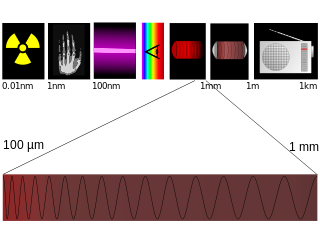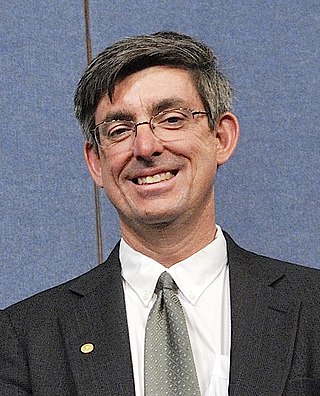Related Research Articles

A laser is a device that emits light through a process of optical amplification based on the stimulated emission of electromagnetic radiation. The word laser is an anacronym that originated as an acronym for light amplification by stimulated emission of radiation. The first laser was built in 1960 by Theodore Maiman at Hughes Research Laboratories, based on theoretical work by Charles H. Townes and Arthur Leonard Schawlow.

DESY, short for Deutsches Elektronen-Synchrotron, is a national research centre for fundamental science located in Hamburg and Zeuthen near Berlin in Germany. It operates particle accelerators used to investigate the structure, dynamics and function of matter, and conducts a broad spectrum of interdisciplinary scientific research in four main areas: particle and high energy physics; photon science; astroparticle physics; and the development, construction and operation of particle accelerators. Its name refers to its first project, an electron synchrotron. DESY is publicly financed by the Federal Republic of Germany and the Federal States of Hamburg and Brandenburg and is a member of the Helmholtz Association.

SLAC National Accelerator Laboratory, originally named the Stanford Linear Accelerator Center, is a federally funded research and development center in Menlo Park, California, United States. Founded in 1962, the laboratory is now sponsored by the United States Department of Energy and administrated by Stanford University. It is the site of the Stanford Linear Accelerator, a 3.2 kilometer (2-mile) linear accelerator constructed in 1966 that could accelerate electrons to energies of 50 GeV.

Terahertz radiation – also known as submillimeter radiation, terahertz waves, tremendously high frequency (THF), T-rays, T-waves, T-light, T-lux or THz – consists of electromagnetic waves within the ITU-designated band of frequencies from 0.3 to 3 terahertz (THz), although the upper boundary is somewhat arbitrary and is considered by some sources as 30 THz. One terahertz is 1012 Hz or 1000 GHz. Wavelengths of radiation in the terahertz band correspondingly range from 1 mm to 0.1 mm = 100 µm. Because terahertz radiation begins at a wavelength of around 1 millimeter and proceeds into shorter wavelengths, it is sometimes known as the submillimeter band, and its radiation as submillimeter waves, especially in astronomy. This band of electromagnetic radiation lies within the transition region between microwave and far infrared, and can be regarded as either.

A free-electron laser (FEL) is a fourth generation light source producing extremely brilliant and short pulses of radiation. An FEL functions much as a laser but employs relativistic electrons as a gain medium instead of using stimulated emission from atomic or molecular excitations. In an FEL, a bunch of electrons passes through a magnetic structure called an undulator or wiggler to generate radiation, which re-interacts with the electrons to make them emit coherently, exponentially increasing its intensity.
The Dual-Axis Radiographic Hydrodynamic Test Facility (DARHT) is a facility at Los Alamos National Laboratory which is part of the Department of Energy's stockpile stewardship program. It uses two large X-ray machines to record three-dimensional interior images of materials. In most experiments, materials undergo hydrodynamic shock to simulate the implosion process in nuclear bombs and/or the effects of severe hydrodynamic stress. The tests are described as "full-scale mockups of the events that trigger the nuclear detonation". The powerful pulsed X-ray beams allow for an ultra-fast motion picture to be constructed showing the details of the process being studied in three dimensions. The tests are compared with computer simulations to help improve the accuracy of the computer codes. Such testing falls under the category of sub-critical testing.

A particle accelerator is a machine that uses electromagnetic fields to propel charged particles to very high speeds and energies, and to contain them in well-defined beams.
An energy recovery linac (ERL) is a type of linear particle accelerator that provides a beam of electrons used to produce x-rays by synchrotron radiation. First proposed in 1965 the idea gained interest since the early 2000s.
A photoinjector is a type of source for intense electron beams which relies on the photoelectric effect. A laser pulse incident onto the cathode of a photoinjector drives electrons out of it, and into the accelerating field of the electron gun. In comparison with the widespread thermionic electron gun, photoinjectors produce electron beams of higher brightness, which means more particles packed into smaller volume of phase space. Photoinjectors serve as the main electron source for single-pass synchrotron light sources, such as free-electron lasers and for ultrafast electron diffraction setups. The first RF photoinjector was developed in 1985 at Los Alamos National Laboratory and used as the source for a free-electron-laser experiment. High-brightness electron beams produced by photoinjectors are used directly or indirectly to probe the molecular, atomic and nuclear structure of matter for fundamental research, as well as material characterization.
Lowell S. Brown was an American theoretical physicist who was a Staff Scientist and Laboratory Fellow at Los Alamos National Laboratory, and Professor Emeritus of physics at University of Washington. He was a student of Julian Schwinger at Harvard University and a recipient of the John Simon Guggenheim Memorial Foundation Fellowship. Brown authored a book on Quantum Field Theory that has received over 5,000 citations, and authored or co-authored over 150 articles that have accumulated over 11,000 citations. Brown died on April 5, 2023, at the age of 89.

Claudio Pellegrini is an Italian/American physics and emeritus professor at University of California, Los Angeles (UCLA), known for his pioneering work on X-ray free electron lasers and collective effects in relativistic particle beams.

Avraham (Avi) Gover is an Israeli professor of Electrical Engineering in the Physical Electronics Department of the Engineering Faculty at Tel Aviv University, specializing in Quantum Electronics and FEL Physics. Gover is also the head of the Israeli Center for Radiation Sources and Applications in Ariel. In 2005, he was awarded the international FEL prize "in recognition for his outstanding contributions to Free Electron Laser science and technology".
Sergei Vladimirovich Bulanov, is a Russian physicist. He received the 1983 State Prize of the USSR, the 2016 Hannes Alfvén Prize for "contributions to the development of large-scale next-step devices in high-temperature plasma physics research", and the Order of Rising Sun with Gold Rays and Rosette in 2020.
Sandra Gail Biedron is an American physicist who serves as the Director of Knowledge Transfer for the Center for Bright Beams as well as professor in Electrical & Computer Engineering and Mechanical Engineering at the University of New Mexico, where in 2021 she mentors nine graduate students and two post-doctoral researchers. Her research includes developing, controlling, operating, and using laser and particle accelerator systems. She is also Chief Scientist of Element Aero, a consulting and R&D company incorporated in 2002. She was elected Fellow of the American Physical Society in 2013.
Dana Dattelbaum is an American physicist and scientist at Los Alamos National Laboratory. She leads NNSA’s Dynamic Materials Properties portfolio at LANL, which provides experimental data, platforms and diagnostics for materials behaviors relevant to nuclear weapons performance, ranging from plutonium to high explosives.

John Louis Sarrao is an American physicist. He was the deputy director for science, technology, and engineering at Los Alamos National Laboratory. As of 2 October 2023, he became the sixth director of SLAC National Accelerator Laboratory
Antoinette Jane (Toni) Taylor is an American physicist known for her research on metamaterials and nanophotonics including terahertz metamaterials for controlling and generating submillimeter radiation. She is Associate Laboratory Director, Physical Sciences at the Los Alamos National Laboratory.
Mary Yvonne Pottenger Hockaday is an American physicist who works at the Los Alamos National Laboratory. She was elected a Fellow of the American Association for the Advancement of Science in 2014 and the American Physical Society in 2022.

Ilan Ben-Zvi is an accelerator physicist and academic. He was the associate chair for accelerator R&D at the Collider-Accelerator Department (C-AD), and is a distinguished scientist emeritus at the Collider-Accelerator Department (C-AD) at Brookhaven National Laboratory.
James Benjamin Rosenzweig is a experimental plasma physicist and a distinguished professor at the University of California, Los Angeles (UCLA). In the field of plasma wakefield acceleration, he is regarded as the father of the non-linear "blowout" interaction regime, where a laser beam, when fired into a plasma at intense levels, expels electrons from the plasma and creates a spherical structure that can effectively focus and accelerate the plasma.
References
- ↑ "2017 HEPAP Membership". US Department of Energy. Retrieved 23 January 2018.
- ↑ "The High Power Electrodynamics Group at Los Alamos National Laboratory" (PDF). Retrieved 23 January 2018.
- ↑ "BESSY FEL Technical Design Report" (PDF). Retrieved 23 January 2018.
- ↑ "Current Status of the MaRIE: (Matter-Radiation Interactions in Extremes)" (PDF). Retrieved 23 January 2018.
- ↑ "Bright lights, big science: Joel Williams helping unleash some of the world's brightest X-rays - SOURCE". SOURCE. 15 February 2017. Retrieved 23 January 2018.
- ↑ "2016 elevated fellow" (PDF). IEEE Fellows Directory.